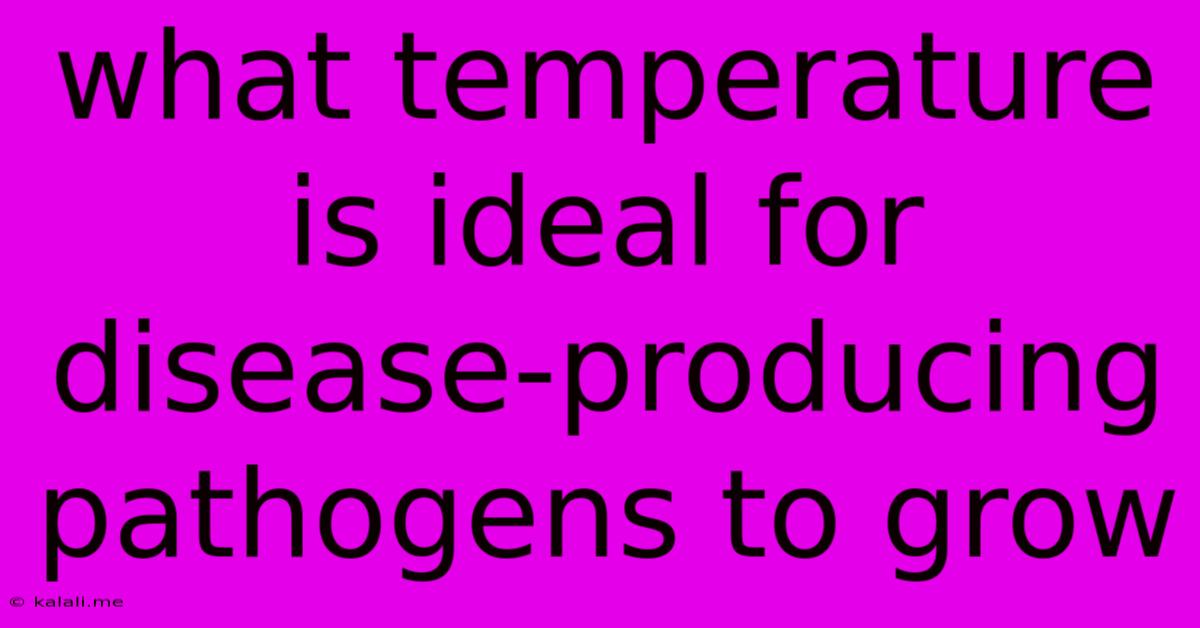What Temperature Is Ideal For Disease-producing Pathogens To Grow
Kalali
May 09, 2025 · 3 min read

Table of Contents
The Ideal Temperature for Pathogen Growth: A Deep Dive into Microbial Thriving
Meta Description: Discover the optimal temperature range for the growth of disease-producing pathogens. Learn about psychrophiles, mesophiles, and thermophiles, and how temperature impacts infection risk. This guide explores the science behind microbial growth and its implications for food safety and disease prevention.
Understanding the temperature preferences of disease-producing pathogens is crucial for preventing infections and ensuring food safety. Different pathogens thrive under specific temperature conditions, influencing their ability to multiply and cause illness. This article will explore the ideal temperature range for pathogen growth, categorizing them based on their temperature preferences.
Understanding Microbial Temperature Preferences
Microorganisms, including pathogens, are categorized based on their optimal growth temperature:
-
Psychrophiles: These cold-loving microbes flourish at temperatures below 20°C (68°F). While some psychrophiles can cause disease, they are less commonly associated with human infections than mesophiles. Examples include certain species of Listeria monocytogenes, which can grow even in refrigerated temperatures, making food safety a significant concern.
-
Mesophiles: This group represents the majority of pathogens affecting humans. Mesophiles thrive in moderate temperatures, generally between 20°C and 45°C (68°F and 113°F). This range encompasses normal human body temperature (37°C or 98.6°F), making mesophiles particularly adept at causing infections. Many common foodborne pathogens, such as Salmonella, E. coli, and Staphylococcus aureus, fall into this category.
-
Thermophiles: These heat-loving microbes prefer temperatures above 45°C (113°F). They are less likely to cause human infections due to their inability to survive at human body temperature. However, some thermophilic bacteria can contaminate high-temperature processed foods if not properly handled.
The Danger Zone: Ideal Temperatures for Pathogen Growth
The "danger zone" for food safety, typically cited as 4°C (40°F) to 60°C (140°F), is the temperature range where most foodborne pathogens multiply rapidly. Within this zone, mesophilic pathogens find optimal conditions for growth and toxin production. Leaving perishable foods within this temperature range for extended periods significantly increases the risk of foodborne illness.
Factors Beyond Temperature
While temperature is a critical factor, it's important to note that other factors influence pathogen growth, including:
- Water Activity (Aw): The amount of available water for microbial growth. Lower water activity inhibits pathogen growth.
- pH: Acidity or alkalinity. Most pathogens prefer neutral pH levels.
- Oxygen Availability: Aerobic pathogens need oxygen, while anaerobic pathogens thrive in oxygen-depleted environments.
- Nutrient Availability: The presence of nutrients essential for microbial growth.
Implications for Food Safety and Disease Prevention
Understanding the ideal temperature range for pathogen growth is paramount for preventing foodborne illnesses and controlling infectious diseases. This knowledge guides food safety practices, including proper refrigeration, cooking temperatures, and rapid cooling of cooked foods. Implementing effective temperature control measures at home, in food service establishments, and in healthcare settings is crucial for minimizing the risk of infection.
Conclusion
The ideal temperature range for the growth of disease-producing pathogens varies significantly depending on the specific microorganism. While mesophiles, thriving at moderate temperatures, pose the greatest threat to human health, understanding the temperature preferences of all types of microbes is crucial for effective disease prevention and food safety. Adherence to safe temperature practices is key to mitigating the risk of infection and ensuring public health.
Latest Posts
Latest Posts
-
Is 35 A Prime Or Composite Number
May 09, 2025
-
What Structure Is Made Of Cellulose In Plant Cells
May 09, 2025
-
What Is The Opposite Of 6
May 09, 2025
-
What Is A 3rd Of 100
May 09, 2025
-
147 Cm In Feet And Inches
May 09, 2025
Related Post
Thank you for visiting our website which covers about What Temperature Is Ideal For Disease-producing Pathogens To Grow . We hope the information provided has been useful to you. Feel free to contact us if you have any questions or need further assistance. See you next time and don't miss to bookmark.